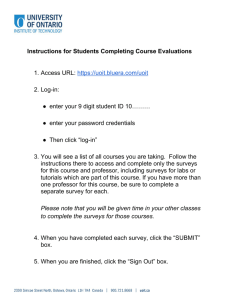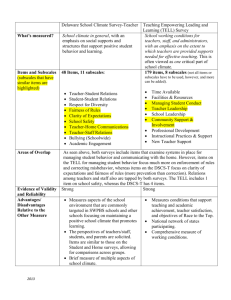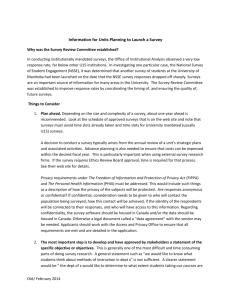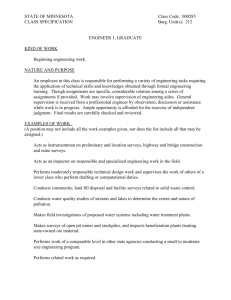Directions for Administering Trust Surveys
advertisement
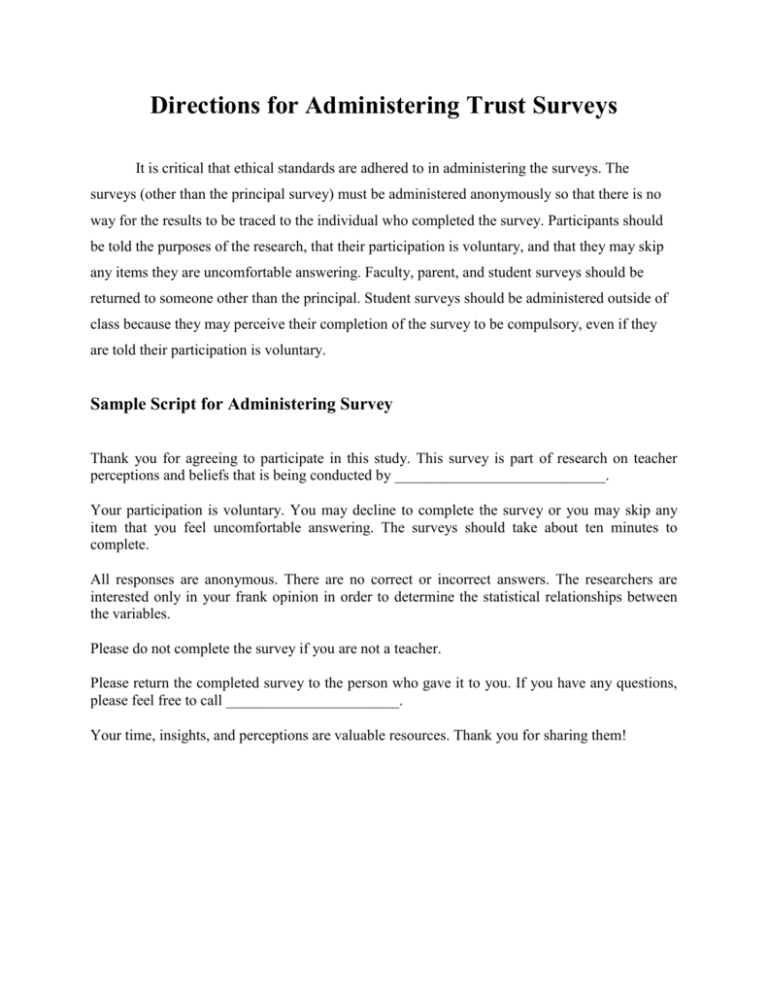
Directions for Administering Trust Surveys It is critical that ethical standards are adhered to in administering the surveys. The surveys (other than the principal survey) must be administered anonymously so that there is no way for the results to be traced to the individual who completed the survey. Participants should be told the purposes of the research, that their participation is voluntary, and that they may skip any items they are uncomfortable answering. Faculty, parent, and student surveys should be returned to someone other than the principal. Student surveys should be administered outside of class because they may perceive their completion of the survey to be compulsory, even if they are told their participation is voluntary. Sample Script for Administering Survey Thank you for agreeing to participate in this study. This survey is part of research on teacher perceptions and beliefs that is being conducted by ____________________________. Your participation is voluntary. You may decline to complete the survey or you may skip any item that you feel uncomfortable answering. The surveys should take about ten minutes to complete. All responses are anonymous. There are no correct or incorrect answers. The researchers are interested only in your frank opinion in order to determine the statistical relationships between the variables. Please do not complete the survey if you are not a teacher. Please return the completed survey to the person who gave it to you. If you have any questions, please feel free to call _______________________. Your time, insights, and perceptions are valuable resources. Thank you for sharing them! Scoring Directions for Parent Survey Scoring directions are provided for each of these surveys, as well as evidence on the reliability and validity of the scales. Directions for calculating a standardized score are included so that schools can compare their results with other schools. The standardized score is presented on a scale with a mean of 500 and a standard deviation of 100, much like an SAT or GRE score. For example, a school with a score of 600 on faculty trust in colleagues is two standard deviations above the average score on faculty trust in colleagues of all schools in the sample. That means that the school has higher faculty trust in colleagues than 84% of the schools in the sample. The range of the standardized scores is presented below: If the score is 200, it is lower than 99% of the schools. If the score is 300, it is lower than 97% of the schools. If the score is 400, it is lower than 84% of the schools. If the score is 500, it is average. If the score is 600, it is higher than 84% of the schools. If the score is 700, it is higher than 97% of the schools. If the score is 800, it is higher than 99% of the schools. The Parent Trust Scale measures two aspects of parent trust: Parent Trust in the School and Parent Trust of the Principal. Step 1: Calculate the average score for each item on the survey. You will need to calculate the average of all the responses to the survey for each item on the questionnaire. You can use a spreadsheet program like Microsoft Excel or calculate the means by hand. If you are using a statistical package such as SPSS, you can skip this step and go directly to Step 3 because the package will calculate the mean of the means. Step 2: Calculate the mean score for your school on each of the two subscales: Use your spreadsheet or statistical package to calculate the school means on each of the subscales. Parent Trust in the School (1 + 2 + 3 + 4 + 5 + 6 + 7 + 8 + 9 + 10) / 10 Parent Trust in the Principal (11 + 12 + 13 + 14 + 15 + 16 + 17 + 18 + 19 + 20 + 21 + 22 + 23 + 24 + 25) / 15 Step 3: Computing the Standardized Scores for the Parent Trust Scale for purposes of comparison. You can convert your school score on each of the subscales to a standardized score with a mean of 500 and a standard deviation of 100 to make comparison with other schools possible. First compute the difference between your school score on parent trust of the school (PaTS) and the mean for the normative sample (PaTS – 5.78). Then multiply the difference by one hundred [100(PTT – 5. 78)]. Next divide the product by the standard deviation of the normative sample (1.68). Then add 500 to the result. You have computed a standardized score Standard Score for Parent Trust in the School. Repeat the process for Parent Trust in the Principal, using the second formula. Calculate standardized trust scores for Parent Trust using the following formulas: Standard Score for Parent Trust in the School (PaTS) = 100(PaTS – 5.78)/1.68 + 500 Standard Score for Parent Trust in the Principal (PaTP) = 100(PaTP – 5.8)/1.68 + 500 Reliability and Validity of the Parent Trust Scale The norms are based on the responses of 428 parents for Parent Trust in Schools and 417 parents for Parent Trust in Principal. The reliabilities for these measures among the norming sample were .95 for Parent Trust in the School and .97 for Parent Trust in the Principal. For more information on the Parent Trust Scale, see Forsyth, P. B. & Adams, C. M. (2004). Social capital in education: Taking stock of concept and measure, In W. K. Hoy & C. G. Miskel, Studies in Leading and Organizing Schools (Volume 4, in press). Information Age Publishing: Greenwich: CT. Guide for Presenting Results of the Trust Surveys The study of trust has been likened to the study of the roots of a delicate plant. Without great care, the examination can damage or even destroy the very thing about which greater understanding is sought. Consequently, I urge caution in the use of these trust scales. Although they can be powerful tools in helping to reveal the underlying dynamics of trust in the relationships within your school, they can do more harm than good if the information is not handled with sensitivity and care. If these data reveal that there are problems in the patterns of trust within your building, there is no better time to begin to exercise trustworthy behavior than in the presentation of these results. While these tools hold the possibility of improving the productivity and effectiveness of your school by identifying areas in need of improved trust, the revelation of distrust or even less than optimal trust, can be hard to take. Principals have described feeling very hurt and disappointed or like they have been “kicked in the stomach” on receiving results that reveal a lack of trust in their leadership. Teachers may have similar feelings. It is important not to lash out in reaction to this perceived insult. It is important to seek to understand the perceptions and feelings that are revealed on the surveys. If you don’t want to know the truth, don’t administer the surveys in the first place. You can be glad for the opportunity to get a window into others’ thinking that might not otherwise be available to you. Suppressing negative results will only lead to greater distrust, so do not administer the surveys if you do not intend to share the results with those who offered their opinions. One thing to keep in mind about the scoring norms is that a score of less than 500 does not necessarily mean that the respondents have indicated distrust of you or others. They may, in fact, have tended to agree more than disagree with the positive statements on the survey but still come out with a standardized score of less than the mean. A score below 500 simply means that the average trust rating at your school was not as high as the average for the larger sample of schools on which the norms were based. For example, the mean score for faculty trust in the principal at the elementary and middle school level is 4.6. A mean score within your school of 4.5, or halfway between slightly agree and somewhat agree, would result in a score that was nonetheless below 500. In presenting the results of the surveys to the faculty or other stakeholders, it is important to avoid blaming or looking for scapegoats. This is the time for openness, vulnerability, and authenticity. It is time for open-minded curiosity about how things got to be the way they are, followed by a conversation about how participants would like for them to be and about how to make that happen. Compelling evidence on the importance of trust to high performing schools has been presented in this book. If your scores indicate there is a problem with trust in your building, you have the opportunity to make it a priority to address these concerns.

